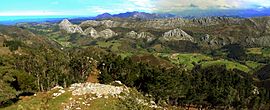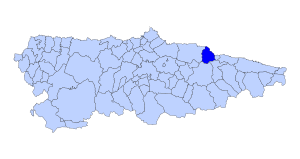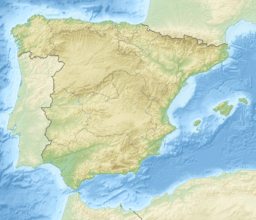Sierra del Sueve facts for kids
Quick facts for kids Sierra del Sueve |
|
|---|---|

Panoramic view of Sierra del Sueve
|
|
| Highest point | |
| Peak | Picu Pienzu |
| Elevation | 1,161 m (3,809 ft) |
| Dimensions | |
| Length | 25 km (16 mi) NE/SW |
| Width | 9 km (5.6 mi) NW/SE |
| Geography | |
| Location | Asturias |
| Country | Spain |
| Range coordinates | 43°25′30″N 5°16′00″W / 43.42500°N 5.26667°W |
| Parent range | Cantabrian Mountains |
| Geology | |
| Orogeny | Alpine orogeny |
| Age of rock | Carboniferous |
| Type of rock | Limestone |
|
Sierra del Sueve
|
|
|---|---|
|
Protected Landscape
|
|
| Protected Landscape Area of Sierra del Sueve | |

Panoramic view of Sierra del Sueve from atop El Fito.
|
|

Location of Protected Landscape Area of Sierra del Sueve in Asturias
|
|
| Country | Spain |
| Area | |
| • Total | 210 km2 (80 sq mi) |
The Sierra del Sueve is a mountain range in Asturias, Spain. It is made mostly of limestone, a type of rock. This mountain range is located near the coast in the eastern part of Asturias. It is also a northern part of the larger Cantabrian Mountains. The Sierra del Sueve stretches across several towns, including Caravia, Colunga, Piloña, Parres, and Ribadesella.
Contents
Exploring the Geography of Sierra del Sueve
The Sierra del Sueve is known for its unique rock formations. The western part has smooth river valleys formed by rocks like shale, limestone, and sandstone. In contrast, the eastern part is mostly made of quartzite, a very hard rock. The middle of the range is dominated by limestone mountains.
Understanding Karst Landscapes
A cool feature of the Sierra del Sueve is its "karst" landscape. This means the limestone has been shaped by water over time. You can see many sinkholes here, which are like big holes in the ground. These are formed when rainwater dissolves the limestone.
Meet the Peaks: Picu Pienzu and El Fito
The Sierra del Sueve has two main parts: the Sueve range and the smaller El Fito mountain. The highest point in the Sueve range is Picu Pienzu, which stands at 1,161 meters (about 3,809 feet) above sea level. Both ranges are mostly made of limestone and quartzite.
Climate and Weather in the Mountains
The weather in Sierra del Sueve is often wet and rainy. Temperatures are usually mild because the sea is close by. It can get very foggy at the top of the mountains, especially due to the sea air. Strong winds are also common here.
Protecting the Sierra del Sueve Landscape
The Sierra del Sueve area is a special "protected landscape." This means it is kept safe to preserve its natural beauty and wildlife. It includes both the mountains and the nearby coast. The protected area covers about 210 square kilometers (81 square miles). It is shared by the towns of Caravia, Colunga, Parres, Piloña, and Ribadesella.
Wildlife and Farming in the Range
Inside the Sueve Range, there is a special hunting reserve. The mountains are also close to the sea, which makes them even more important for nature. Local people use parts of the land for farming and for grazing animals. You can see cows, goats, sheep, horses, and ponies grazing in the mountain pastures.
Discovering the Flora: Plants and Trees
Even though some trees have been cut down in the past, Sierra del Sueve still has some beautiful forests. One special forest is called La Biescona. It's a beech forest located near the coast in the northern part of the range. You can also find groups of chestnut trees there. Some areas have pine and eucalyptus trees that were planted a long time ago.
- Forest Details: The most notable forest area is in the north. It has many holly trees and espinera (hawthorn). Other trees include ash, birch, elm, hazel, maple, yew, and wild pear.
- Rare Ferns: At the bottom of the mountain on its north side, there's a unique microclimate. This special weather allows rare ferns to grow. These ferns are very unusual to find outside tropical areas, not just in Asturias but across Europe. Two types of rare ferns found here are the mattress fern (helechilla) and the Killarney fern (Trichomanes speciosum). Both are listed as threatened plants in the region.
Exploring the Fauna: Animals of Sierra del Sueve
The Sierra del Sueve is home to many interesting animals. You might spot a fox, wild boar, or roe deer.
The Asturcon Horse: A Special Breed
One very special animal here is the Asturcon horse. This is a rare breed of horse from Asturias. These horses are usually black or dark brown, and they don't have any white markings. They are a small breed and move with an easy, smooth walk instead of a trot. This made them popular in ancient times, and the Romans even called them “asturcones.” This breed was once close to disappearing, but now groups are working to protect and breed them.
Other Wildlife and Birds of Prey
In the 1960s, a type of deer called Dama dama (fallow deer) was brought to the area for hunting. They adapted well, and their numbers grew. However, attempts to introduce male deer, called stags (Cervus elaphus), were not as successful, and they moved to other areas.
Other important animals include:
- Alpine chough (Pyrrhocorax graculus), a type of bird.
- Golden eagle (Aquila chrysaetos), a large bird of prey.
- Common bent-wing bats (Miniopterus schreibersi), which live in caves.
- Reptiles like the Iberian rock lizard (Iberolacerta monticola).
You can also find birds of prey like the Egyptian vulture (Neophron percnopterus), which is a threatened species.
Visiting Sierra del Sueve: Tourism and Activities
It's easy to get to Sierra del Sueve by road. You can take roads like AS-258 from Infiesto and Colunga, or AS-432 to La Torre, and N-632.
Amazing Views from El Fito
The viewpoint at the top of El Fito mountain offers amazing views. From there, you can see the beautiful coast from Caravia all the way to Villaviciosa.
Hiking and Exploring the Mountains
Hiking and mountaineering are popular activities in the Sierra del Sueve. There are different paths you can take:
- One route starts in the town of Carandía.
- Another goes through Portil, the MUA, and Requexu lake.
- You can also start a hike from Piloña.
To help visitors, an Interpretation Center for the Sierra del Sueve was opened in April 2007. It's located in the City of Colunga and helps guide people who want to explore both the sea and the mountains.
See also
 In Spanish: Sierra del Sueve para niños
In Spanish: Sierra del Sueve para niños


